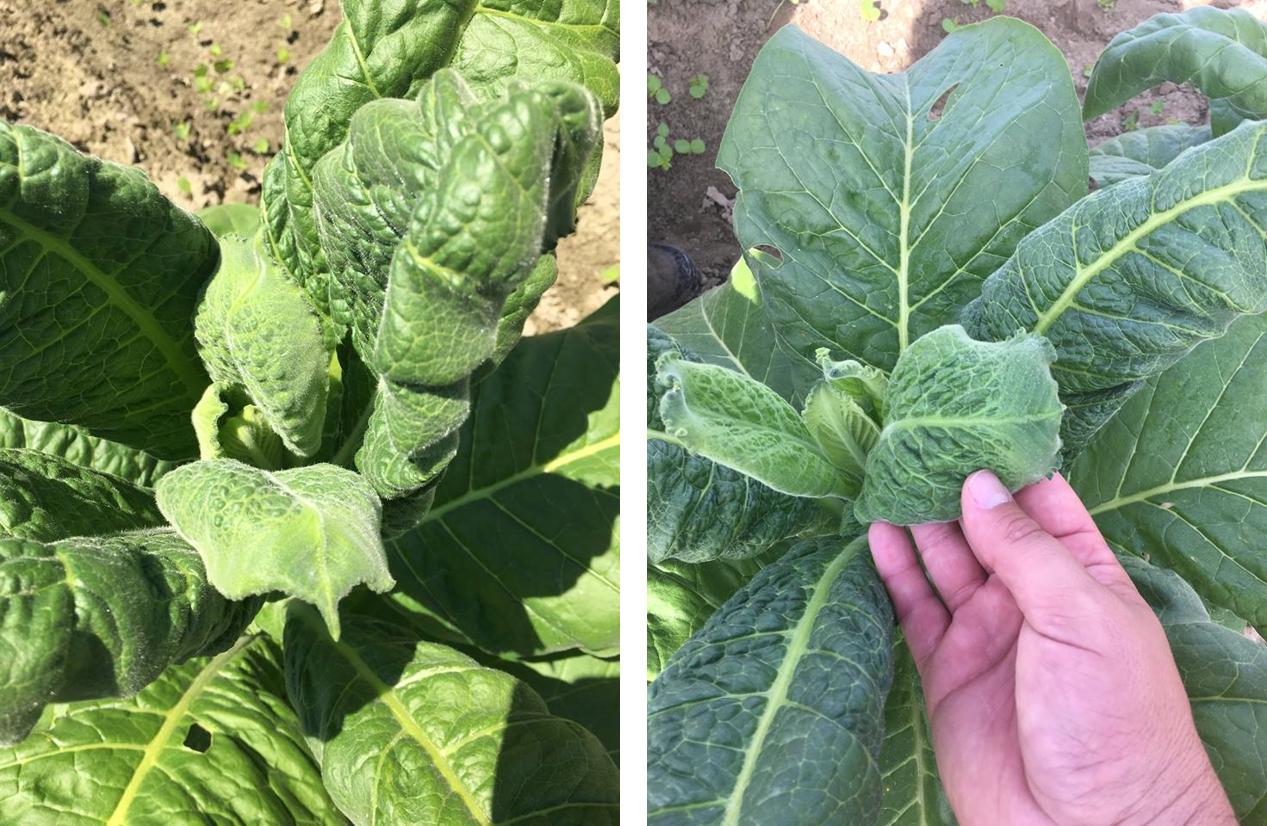A number of dicamba drift situations, primarily tobacco and soybean, have been observed in recent days. Crop sensitivity to dicamba varies, but all broadleaf crops are sensitive. Tobacco, soybeans, other beans and peas, sweetpotato, and grapes are extremely sensitive. Cotton, peanuts, and vegetable crops, including peppers, tomato, watermelon, cucumber, cantaloupe, and squash, are somewhat less sensitive, but still highly sensitive.
Minute amounts of drift can cause significant injury.
Impact on Soybeans
The impact of dicamba drift onto soybeans depends upon the dosage and the growth stage at time of drift. Soybeans hit during the vegetative stage can recover somewhat from dicamba drift; in some cases, yield may not be impacted. Drift occurring during reproductive stages will likely reduce yield.
Impact on Tobacco
Any dicamba drift onto tobacco results in a complete crop loss. Tobacco purchasers have consistently stated that tobacco exhibiting symptoms of injury from any non-registered pesticide is not marketable and must be destroyed; that is a significant liability and/or economic impact for growers. Visual injury, even in the absence of detectable residues, is grounds for contracting companies to require crop destruction. A similar situation may exist for vegetables grown under contract.
Label Requirements and Stewardship Practices
Applicators must follow all label directions. In the case of the dicamba products registered for Xtend soybeans and XtendFlex cotton, that means following the supplemental labels, the North Carolina Special Local Need labels, and the web sites referred to on the supplemental labels. Remember, avoiding drift is the responsibility of the applicator.
- APPROVED PRODUCTS. Engenia and XtendiMax are the only currently available dicamba-containing products registered for use on Xtend soybean or XtendFlex cotton. Although not completely non-volatile, these formulations are less volatile than non-approved brands. These are the only brands that should be applied to Xtend soybean or XtendFlex cotton.
- NOZZLES, PRESSURE, VOLUME. These three factors determine droplet size and the percentage of droplets that fall in the “driftable fines” category.
- Use only approved nozzles when applying Engenia or XtendiMax. Refer to the following web sites for approved nozzles:
– For Engenia: www.engeniatankmix.com
– For Xtendimax: www.xtendimaxapplicationrequirements.com
- Pressure affects droplet size. Operate within the recommended pressure ranges specified on the web sites.
- Use a minimum spray volume of 10 GPA; 15 GPA is preferred.
- BOOM HEIGHT. Greater boom heights result in greater drift potential. Keep boom as low as possible and no more than 24 inches above the target.
- WIND SPEED. Drift potential increases with increasing wind speed. North Carolina Special Local Need labels for Engenia and XtendiMax specify a maximum wind speed of 10 MPH.
- INVERSIONS. Thermal inversions are common during early morning hours and late afternoon. Application during an inversion can result in long-distance drift. Very calm winds may indicate an inversion, hence the requirement for a minimum 3 MPH wind during Engenia or Xtendimax application. It is best to apply dicamba between the hours of 9 AM and 4 PM.
- WIND DIRECTION. This is one of the greatest factors affecting off-target deposition. Do not spray if the wind is blowing toward a sensitive crop (if you can’t afford to buy that crop, don’t spray). Even if the wind is not toward a sensitive crop, use some common sense and do not spray adjacent to a sensitive crop. Remember that wind direction can and does change often during the day. Wind direction should be checked frequently, especially if sensitive crops are nearby.
- TRAVEL SPEED. Greater travel speeds cause turbulence behind the sprayer, and that can lead to more drift. Engenia and XtendiMax labels specify a maximum travel speed of 15 MPH; 10 MPH or slower is preferred.
- TANK MIXING. Tank-mix partners may affect physical properties of the spray solution, leading to a reduction in droplet size. Each tank-mix partner must be tested for its effect on droplet size before it is approved. Use only approved tank mixes as listed on the web sites.
- DRIFT REDUCTION AGENTS. Drift reduction agents (DRA) work by reducing fine droplets. For some tank mixes, a DRA is required; see web sites. If a DRA is not required, it is still a good idea to use one if sensitive crops are nearby.
- ADJUVANTS. Other than DRA’s, a number of adjuvants are approved for use with Engenia and XtendiMax; see web sites for approved products. If mixing Engenia or XtendiMax with an approved glyphosate product, additional adjuvants are of questionable value. Do not use AMS or any adjuvant containing AMS; that increases volatility of the dicamba products.
*This post was originally written by Dr. Alan York, NCSU Weed Extension Specialist.








